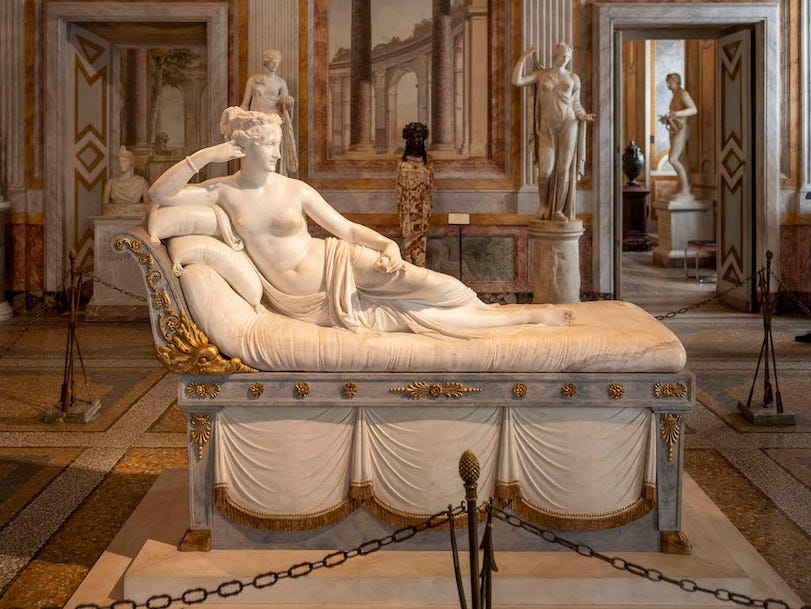- An Austrian tourist broke two toes off the sculpture “Paolina Borghese as Venus Victrix” after sitting on it for a photo Friday, Italy’s Museo Antonio Canova said in a Facebook post.
- The plaster cast dates back to 1804 and was created by one of Italy’s best-known neoclassical sculptors, Antonio Canova.
- According to the museum’s Facebook post, the fragments were found, and the cast can be restored.
- The tourist’s identity has not been made public.
- The Italian news agency Adnkronos has shared an email it says the tourist sent to local authorities in which he apologized.
- Visit Insider’s homepage for more stories.
A tourist broke the toes of a famous sculpture that dates back to 1804 at Italy’s Museo Antonio Canova on Friday, according to a Facebook post shared by the museum.
Multiple reports, including one from Artnet News, say the tourist was attempting to take a selfie while sitting on the neoclassical sculptor Antonio Canova’s plaster “Paolina Borghese as Venus Victrix” at the museum in Possagno, just over an hour outside Venice, when the mishap occurred.
A report from the Italian news agency Adnkronos says the visitor realized he had broken the sculpture after “lying next to the precious work, being photographed by another person,” according to a translation from Italian.
Reuters has since shared footage that shows a person sitting on the sculpture, while someone else appears to be taking his photo.

The sculpture displayed in the Northern Italy museum is a plaster cast for the marble version, "Paolina Borghese as Venus Victrix," which is in Rome's Galleria Borghese.
On Saturday, the Museo Antonio Canova shared details of the incident on Facebook as well as a photo of the broken sculpture
In a Facebook post, the Museo Antonio Canova said an Austrian tourist was responsible for breaking two toes of the sculpture. Adnkronos and Reuters, however, say the sculpture lost three toes.
The museum's Facebook post added that the visitor left the scene and didn't notify the museum of the breakage.
"A few minutes later our room guards detected the damage and raised the alarm," the museum's statement, translated from Italian, said. "An emergency situation was immediately declared."
The museum said on Facebook that the fragments of the broken sculpture were found and that the cast could be restored. The museum said it was discussing the artwork's future restoration in the coming weeks.
This won't be the first time the statue has been restored. As Artnet News points out, citing the Italian newspaper la Repubblica, the plaster cast lost its head after a Christmas bombing raid in 1917 during World War I and was restored years later in 2004.
The tourist's identity has not been released to the public, but he has reportedly apologized for the incident
Adnkronos said in its report that when the tourist realized he had broken part of the structure, the museumgoer was "visibly disturbed" by what had happened and moved out of view of surveillance cameras.
Speaking with the Italian newspaper Il Fatto Quotidiano, Valerio Favero, the mayor of Possagno, confirmed that the tourist had been identified.
"The really incredible thing is that he had not thought of reporting the incident," Favero was quoted saying in the report, translated from Italian. "In my eyes, the fact of leaving the sculpture in that condition is criminal."

According to the same report, surveillance footage was used to identify the tourist.
Artnet News reports that the museum could identify the tourist involved thanks to a new check-in process in which visitors sign their names on entering. The practice has been rolled out at museums since reopening after being closed because of the coronavirus, according to Artnet News.
Using a translator, the police contacted the woman who had signed in the group, which included the man suspected of causing the damage, according to Adnkronos. She told the officers the man was her husband, the report says.
After the call, Adnkronos reports that the police received an apologetic email from the man, who said he was on the trip for his 50th birthday.
"During the visit to the Museum of Possagno, I sat on the statue, without however realizing the damage that I evidently caused," he wrote in the email, translated from Italian, according to Adnkronos. "I apologize in every way."
Representatives for the Museo Antonio Canova did not immediately respond to Insider's request for comment.
- Read more:
- You and 9 friends could stay in a 15th-century monastery on an island in Croatia
- The most haunted house in Ireland is now for sale, and it could be yours if you're not afraid of a few scary stories
- Iceland wants to help you release pent-up emotions by broadcasting your screams across its beautiful landscapes
